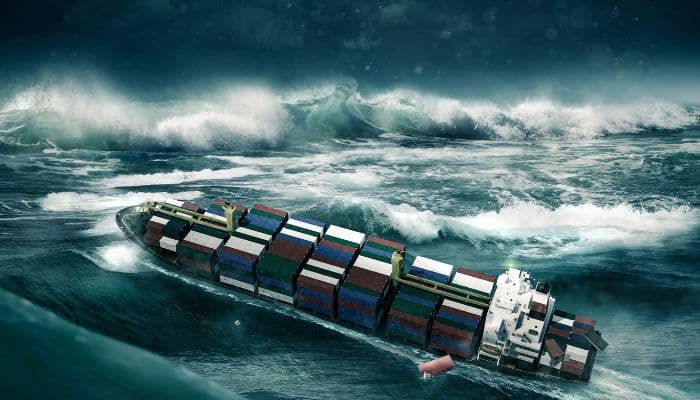For centuries, the vast and mysterious Bermuda Triangle has been at the center of countless theories surrounding the unexplained disappearances of ships and planes. While natural phenomena like rogue waves and magnetic anomalies offer scientific explanations, one theory that has captured the imagination of adventurers and conspiracy theorists alike is the possible involvement of a long-extinct sea monster: the Megalodon.

Believed to have roamed the oceans millions of years ago, Megalodon was a massive, prehistoric shark measuring up to 90 feet long, dwarfing modern great white sharks. Some theorists claim that this ancient predator might still be lurking in the deep, responsible for the disappearance of ships passing through the Bermuda Triangle. But could such a creature still exist, and if so, could it be attacking vessels in one of the world’s most mysterious regions?
The Rise of Megalodon: The Apex Predator of the Ancient Seas
Megalodon (Carcharocles megalodon) ruled the oceans between 23 and 3.6 million years ago, during the Miocene and Pliocene epochs. As the largest shark to have ever lived, Megalodon was a fearsome predator, with jaws that could reach over 10 feet wide and teeth the size of a human hand. This massive shark feasted on whales, dolphins, and other marine life, striking fear into anything that swam in its domain.
Fossils of Megalodon teeth have been found in oceans worldwide, suggesting that this enormous predator had a global range, dominating the seas for millions of years. However, the general consensus among paleontologists is that Megalodon went extinct due to cooling oceans, a decline in food sources, and competition with smaller, more agile predators like the ancestors of modern great white sharks.

Despite the scientific evidence pointing to its extinction, the idea that Megalodon could have survived in the depths of the ocean, hidden from human discovery, has become a popular theory among those fascinated by marine mysteries—especially in regions as enigmatic as the Bermuda Triangle.
The Bermuda Triangle and the Megalodon Connection
The Bermuda Triangle, with its history of shipwrecks and disappearances, is the perfect breeding ground for theories involving ancient sea monsters. The area’s reputation for swallowing vessels without a trace has led some to suggest that a creature as large and powerful as Megalodon could be responsible.
While it may sound like the stuff of legend, proponents of the Megalodon theory point to certain key elements to support the idea:
1. Unexplained Ship Disappearances
Numerous ships have disappeared in the Bermuda Triangle without sending distress signals or leaving behind debris. Some believe that a massive sea predator could attack with such speed and force that a ship wouldn’t have time to react, dragging it to the bottom of the ocean without a trace. A 90-foot Megalodon would be capable of capsizing smaller vessels or causing enough damage to sink them swiftly.

2. Deep Ocean Trenches and Caverns
The Bermuda Triangle is home to some of the deepest parts of the Atlantic Ocean, including the Puerto Rico Trench, which plunges over 27,000 feet below sea level. Some theorists argue that such deep ocean trenches could serve as hiding places for prehistoric creatures like Megalodon, allowing them to escape detection by humans for millions of years. These unexplored areas could theoretically harbor unknown species that have managed to survive in the extreme conditions of the deep sea.
3. Fishermen and Sailor Sightings
There have been numerous reports over the years from fishermen, sailors, and even deep-sea explorers who claim to have seen massive, unidentified sharks larger than any known species. These accounts have fueled speculation that Megalodon or a similarly large creature might still be patrolling the deep, occasionally rising to the surface to hunt.
In one particularly famous incident in 1918, Australian fishermen reported that a shark far larger than any known species attacked their fishing boat, taking the entire catch of fish in one bite. While the story is anecdotal, it has been cited as possible evidence that Megalodon might still be alive in the deep ocean.
Scientific Counterarguments: Could Megalodon Really Survive?
While the idea of Megalodon lurking in the Bermuda Triangle is thrilling, the scientific community largely dismisses the possibility of its survival. Here are a few reasons why:
1. Fossil Evidence

The most compelling argument against the existence of Megalodon is the lack of fossil evidence beyond 3.6 million years ago. If such a large predator were still alive, we would expect to find more recent fossilized teeth, bones, or remains. Given Megalodon’s enormous size and its once-global range, it seems unlikely that such a creature could remain hidden for millions of years without leaving behind physical evidence.
2. Food Source
Megalodon was an apex predator that feasted on large marine mammals, such as whales. Modern ocean ecosystems are vastly different from the Miocene and Pliocene epochs, with fewer large prey available for a predator of Megalodon’s size. Without a consistent food source, it would be nearly impossible for such a massive creature to survive for millions of years.
3. Ocean Depths
While the deep ocean remains largely unexplored, it’s unlikely that a predator as large as Megalodon could survive exclusively in deep trenches. Megalodon was a surface hunter, requiring large prey that live closer to the ocean’s surface. The cold, dark, and nutrient-poor environment of deep ocean trenches like the Puerto Rico Trench is unsuitable for a predator that once thrived in warmer, shallow waters.
Conclusion: Is the Megalodon Theory Just a Myth?
While the idea of Megalodon attacking ships in the Bermuda Triangle is an exciting theory, it is not supported by scientific evidence. The disappearances in the Bermuda Triangle are likely caused by a combination of natural phenomena, human error, and harsh environmental conditions, rather than the resurgence of a prehistoric sea monster.
Nevertheless, the fascination with Megalodon endures, fueled by our desire to believe that the deep oceans may still hold undiscovered wonders—and perhaps even a few ancient secrets. For now, the story of Megalodon in the Bermuda Triangle remains a captivating mystery, combining the allure of real-world scientific inquiry with the excitement of legendary sea monsters.





